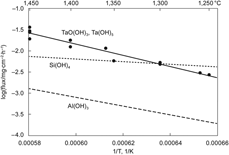Crossref Citations
This article has been cited by the following publications. This list is generated based on data provided by
Crossref.
Bauschlicher, Charles W.
Jacobson, Nathan S.
and
Myers, Dwight L.
2019.
Quantum chemical calculations of the thermochemistry of tantalum oxyhydroxide species.
Journal of the American Ceramic Society,
Vol. 102,
Issue. 7,
p.
3836.
Harries, Dennis
2019.
Interface Processes and Anomalous Oxygen Transport in Rapid Metal Oxidation and Magnetite Formation at Protoplanetary Conditions.
ACS Earth and Space Chemistry,
Vol. 3,
Issue. 10,
p.
2207.
Plyasunov, Andrey V.
2020.
Predicting Solubility of Oxides of Metals and Metalloids in Supercritical Water.
Industrial & Engineering Chemistry Research,
Vol. 59,
Issue. 2,
p.
970.
Fegley, Bruce
Lodders, Katharina
and
Jacobson, Nathan S.
2020.
Volatile element chemistry during accretion of the earth.
Geochemistry,
Vol. 80,
Issue. 1,
p.
125594.
L. Smialek, James
2020.
Relative Ti2AlC Scale Volatility under 1300 °C Combustion Conditions.
Coatings,
Vol. 10,
Issue. 2,
p.
142.
2020.
Combustion Emissions.
p.
469.
Holcomb, Gordon R.
Baltrus, John P.
Tylczak, Joseph H.
and
Ohodnicki, Paul R.
2020.
Volatilization Behavior of Supported Au Nanoparticle Arrays under H2 at High Temperature.
The Journal of Physical Chemistry C,
Vol. 124,
Issue. 17,
p.
9506.
Benedicto, Marcos
and
Tejedor, Paloma
2021.
Kinetics of HfO2 etching and impurity elimination with atomic hydrogen beams.
Applied Surface Science,
Vol. 566,
Issue. ,
p.
150607.
Parker, Mariah L.
Jian, Jiwen
and
Gibson, John K.
2021.
Bond dissociation energies of low-valent lanthanide hydroxides: lower limits from ion–molecule reactions and comparisons with fluorides.
Physical Chemistry Chemical Physics,
Vol. 23,
Issue. 19,
p.
11314.
Bauschlicher, Charles W.
and
Jacobson, Nathan S.
2021.
Thermochemistry of Gaseous Ytterbium and Gadolinium Hydroxides and Oxyhydroxides.
The Journal of Physical Chemistry A,
Vol. 125,
Issue. 14,
p.
2913.
Bauschlicher, Charles W.
Jacobson, Nathan S.
Myers, Dwight L.
and
Opila, Elizabeth J.
2022.
Computational Chemistry Derivation of Cr, Mn, and La Hydroxide and Oxyhydroxide Thermodynamics.
The Journal of Physical Chemistry A,
Vol. 126,
Issue. 9,
p.
1551.
Sangsuebsri, Methanan
Pokwitidkul, Suwijak
Wiman, Panya
Tanaka, Youhei
Thublaor, Thammaporn
Sriariyanun, M.
Cheng, Y.-S.
Bhattacharyya, D.
Venkatachalam, P.
and
Gundupalli, M.P.
2023.
Manganese Constituent in Stainless Steels Oxidized in Oxygen Containing Water Vapor at 800 °C: High Temperature Oxidation and Volatilization.
E3S Web of Conferences,
Vol. 428,
Issue. ,
p.
02012.
Duthoit, Guillaume
Vande Put, Aurélie
Caussat, Brigitte
Vergnes, Hugues
and
Monceau, Daniel
2024.
Influence of Water Vapor and Local Gas Velocity on the Oxidation Kinetics of In625 at 900 °C: Experimental Study and CFD Gas Phase Simulation.
High Temperature Corrosion of Materials,
Vol. 101,
Issue. 6,
p.
1513.
Bauschlicher, Charles W.
Jacobson, Nathan S.
and
Bodenschatz, Cameron J.
2024.
Compound database for gaseous metal hydroxides and oxyhydroxides.
Calphad,
Vol. 85,
Issue. ,
p.
102707.
Ndukwe, Agha
Deekae, Miracle
Ejike, Wisdom
Okon, Kooffreh
Ozoh, Chibuike
Chiemela, Uchechukwu
Ikele, Udochukwu
Chibuzor, Ihechi
Ezeasia, Desmond
Ikwuka, Ifunanya
and
Achonwa, George
2025.
Metal Corrosion in High Temperature Conditions: A Review.
Zastita Materijala,



